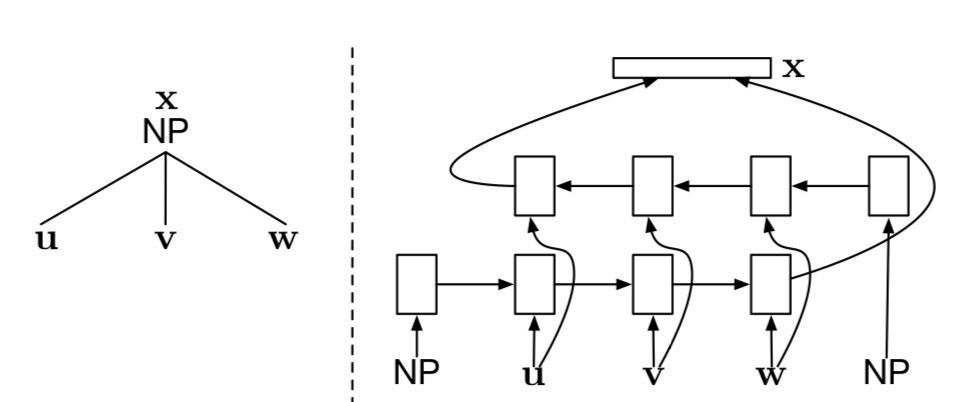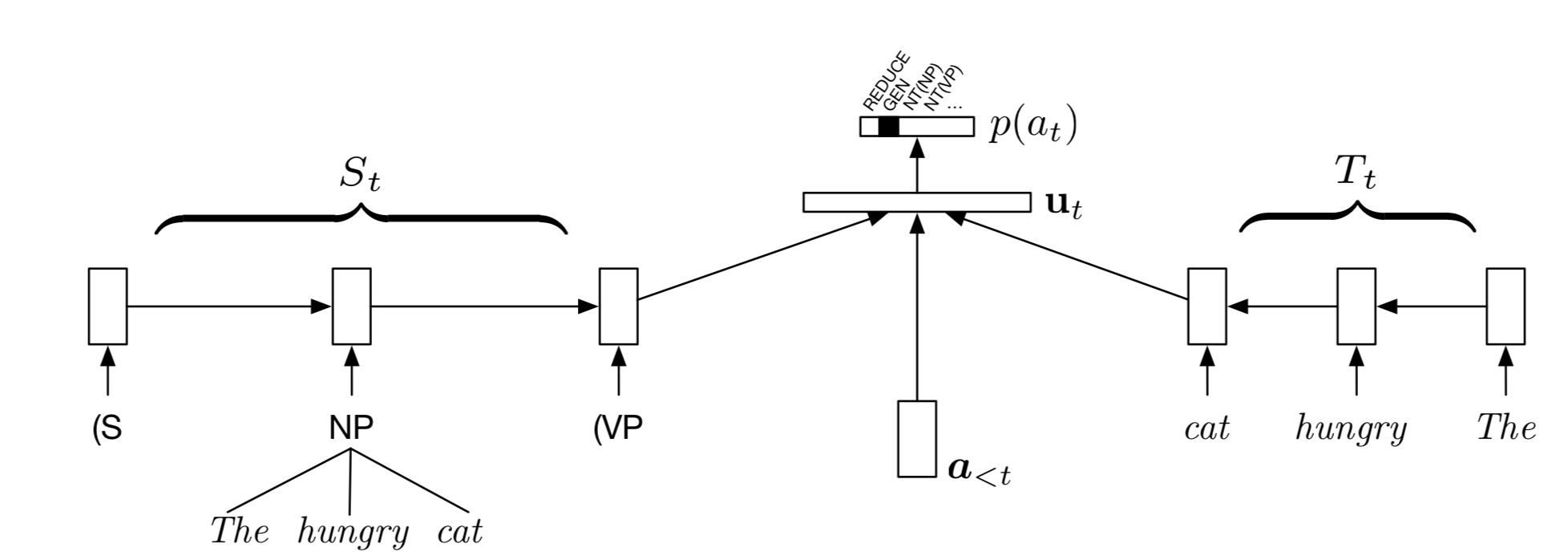Recurrent neural network grammars 实现语言的分层形式表达,RNNG中存在的bias为top bias,较符合语言逻辑。
本文介绍了Recurrent neural network grammars (RNNG)的原理,优点和实验结果。
原文参考 Recurrent Neural Network Grammars (Chris Dyer, et al., 2016)
写中文的notes好累啊,所以这篇暂时是英文的 ( ´▽`)
Intro
Top-down Parsing and Generation
- Parser Transition
– bottom-up shift-reduce recognition algorithms
– the parsing algorithm: mapping from sequences of words to parse trees.
– Stack($S$): contains terminal symbols, open nonterminal symbols and completed constituents. Begin with empty.
– Input Buffer(B): contains unprocesses terminal symbols. Begin with complete sequence of words.
– Info. to train a classifier: current contents on Stack (some part of $y_t$) and Buffer (part of $x_t$)
– Top-down parsing example Figure 1(a) - Generator Transitions
– Algorithm that stochastically generates trees and terminal symbols.
– Need two changes of parsing algorithm: no input buffer of unprocesses words, rather there is an Output Buffer ($T$)
– Instead of a SHIFT operation, there are GEN($x$) operations which generate terminal symbol $x \in \Sigma$ and add it to the top of the Stack (S) and the Output Buffer ($T$)
– Predict action according to a conditional distibution that depends on the current content of $S$ and $T$. when using RNN model, we also use information of past actions. see RNNG

RNNG Sturcture
RNNG</font>
- Generate a set of actions
- at each timestep, we use information: Previous terminal symbols (Tt); Previous actions (a<1); Current
stack contents (St). - $T_t, a<t$ could use normal RNNs or any RNN variants; But St is more complicated:
- The elements of the stack are more complicated objects than symbols from a discrete alphabet: open nonterminals, terminals, and full trees are all present on the stack.
- Define a new syntactic composition function that recursively defines representations of trees.
- it is manipulated by push and pop operations.
- Need a stack LSTMs or RNNs to obtain the representations of $S$ under push and pop operations.
- The elements of the stack are more complicated objects than symbols from a discrete alphabet: open nonterminals, terminals, and full trees are all present on the stack.
Syntactic Composition Function
- Structure see Figure 2
- Syntactic composition function based on bidirectional LSTMs that is executed during a REDUCE operation:
- The parser pops a sequence of completed subtrees and/or tokens (together with their vector embeddings) from the stack;
- makes them children of the most recent open nonterminal on the stack
- completing the constituent.
- A bidirectional LSTMs based composition function to compute an embedding of this new subtree.

Stack LSTMs or RNNs
- See Figure 3
- A stack LSTM extends a conventional left-to-right LSTM with the addition of a stack pointer (notated as TOP in the figure).
- the boxes in the lowest rows represent stack contents, which are the inputs to the LSTM
- the upper rows are the outputs of the LSTM (in this paper, only the output pointed to by TOP is ever accessed)
- and the middle rows are the memory cells and gates.
- This figure shows three configurations
- a stack with a single element (left)
- the result of a pop operation to this (middle)
- and then the result of applying a push operation (right)
- Arrows represent function applications (usually affine transformations followed by a nonlinearity).

Complete RNNG model
- Structure see Figure 4 and Table 1
- !待编辑,需要比较简洁的演示

Table 1: Line 7

Implementation and task
Parameter Estimation
- RNNGs jointly model sequences of words together with a “tree structure’s $p_{\theta}(\mathbf x,\mathbf y)$
- Any parse tree can be converted to a sequence of actions (depth first traversal) and vice versa
- we use trees from the Penn Treebanck
- We could treat the non-generation actions as latent variables or learn them with RL, effectively making this a problem of grammar induction
Inference of RNNGs
- An RNNG is a joint distribution $p(\mathbf {x},\mathbf {y})$ over strings $\mathbf {x}$ and parse trees $\mathbf {y}$
- Two inference questions:
- $p(\mathbf{x})$ for given $\mathbf{x}$: Language modeling.
- $argmax_{\mathbf{y}} p(\mathbf{y}\mid\mathbf{x})$ for a given $\mathbf{x}$: parsing.
- Dynamic programming algorithms we often rely on are of no help here
- Could use Importance Sampling to do both by sampling from a discriminatively trained model: MC integral.
RNNG as a mini-linguist
- Replace composition with one that computes attention over objects in the composed sequence, using embedding of NT for similarity.
- Idea: to compute representation of NP, we may need to pay more attention on N in that NP.
Summary
- Language is hierarchical, and this inductive bias can be encoded into an RNN-style model.
- when we’re building a learning model, we do have to build some kind of bias on these models.
- The licensing context (e.g., not…anybody) depends on recursive structure (syntax)
- RNNGs work by simulating a tree traversal-like a pushdown automaton, but with continuous rather than finite history.
- it uses continuous representations.
- simply training on the word sequences and it’s bracketed sequences (trees) does not generate well-formed trees.
- because there’s no internal mechanism to enforce you’ve got a well bracketed string.
- traverse the tree also traverse the string.
- Modeled by RNNs encoding previous tokens, previous actions, and stack contents A stack LSTM evolves with stack contents.
- The final representation computed by a stack LSTM has a top-down recency bias, rather than left-to- right bias, which might be useful in modeling sentences.
- Effective for parsing and language modeling, and seems to capture linguistic intuitions about headedness.
- interesting results: parsing performance of Stack-only RNNG is the best; without Stack info, the system did not work very well on both parsing and LM
∗ leaving out stack is harmful
∗ using it on its own works slightly better than complete model on parsing.
- interesting results: parsing performance of Stack-only RNNG is the best; without Stack info, the system did not work very well on both parsing and LM
References
Dyer, C., Kuncoro, A., Ballesteros, M., & Smith, N. A. (2016). Recurrent neural network grammars. arXiv preprint arXiv:1602.07776.